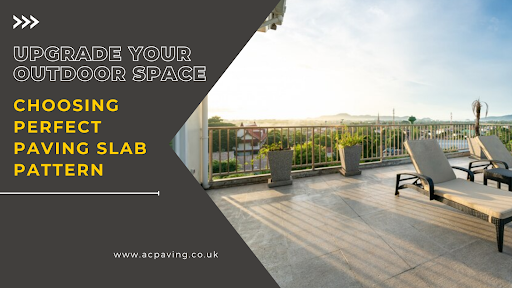Dolly Parton once said, “If you don’t like the road you’re walking, start paving another one.”
But when it comes to paving your outdoor area, you can create a unique pattern. Paving slabs UK are a sought-after choice to design both practical and aesthetically pleasing outdoor areas. They are versatile and suitable for many uses, like driveways, patios, and walkways.
However, you must choose a proper slab laying pattern to make your outdoor space functional and aesthetically pleasing. In addition to adding to the pavement’s aesthetic appeal, the pattern affects the paved area’s longevity and maintenance needs.
The choice of pattern should depend on several factors, as there are several possibilities available, ranging from the straightforward stretcher bond to the complex circular designs. This post will examine some of the most often used paving slab laying designs in more detail.
Understanding design fundamentals
- Size and shape
The size and shape of the paving slabs mainly determine the visual effect and practical utility of patio spaces. Larger slabs can provide an air of spaciousness in small areas, while smaller pieces can give more detailed patterns for a more textured appearance.
Regardless of its shape, it should go well with the user’s design and how the garden is laid out.
- Colours
The choice of colour for pavement is quite crucial since it affects how the outside area feels and blends in with its surroundings.
While dark-coloured paving slabs give a solid base that contrasts nicely with flamboyant garden components, light tones can brighten regions that receive little sunshine.
You can create a uniform appearance by maintaining a consistent colour tone across the slabs. Alternatively, you can use different colours to distinguish zones or provide visual interest.
- Motifs
An eye-catching focal point (motif) that grabs attention and gives the patio personality can be created by incorporating a theme into a pavement pattern.
However, to ensure that the theme complements rather than overwhelms the space, it should be placed in the centre of the room or at a naturally occurring centre of interest. The intricacy of the design should fit the overall aesthetic, enhancing rather than detracting from the garden’s current elements.
5 popular paving slab laying patterns
- Random laying pattern
Pavement laid in a random pattern, sometimes called “crazy” pavement, has a more organic and natural appearance. It entails arranging slabs in an erratic, non-repetitive pattern that varies in size and shape. This method is beneficial for natural sandstone paving as it can hide incisions and alterations.
- Stack bond laying pattern
A more straightforward laying design is a stack bond patio layout. Another name for it is the “chessboard effect.” The paving stones and slab size you select will determine the effect and attractiveness of this patio design.
The versatility of the stack bond laying pattern is one of its main advantages for patios. It is also a simple pattern to lay. It also has very little waste and very few cuts.
The most important thing to keep in mind while using the stack bond patio pattern is the precision of the joints and falls. Even the most minor flaws will be obvious. In that regard, this patio-laying plan is really unforgiving.
- Stretcher bond laying pattern
Stretcher bond, often referred to as running bond or half bond, is a traditional pavement pattern that is arguably the most popular. A stretcher bond paving design is visually appealing since it is easier to create and has a consistent pattern. It most closely resembles a house’s brickwork.
Even though this sandstone paving pattern is relatively simple, many homeowners in the UK are drawn to it because of its popularity. This is mostly because a contractor can lay a simple design faster than a more intricate pattern, which makes it a more cost-effective choice for individuals searching for a less expensive solution.
Finally, stretcher bond paving requires very little cutting and produces almost little waste, making it an excellent choice for those who want to minimise their environmental impact.
- Herringbone pattern
Rows of zigzagging pavers put in a diagonal or straight up and down manner create a herringbone lay pattern. One paver’s short edge meets the next’s long edge to make a sequence of L-shapers.
While smaller rectangular pavers are appropriate for a conventional herringbone pattern, if you want to create a more modern, streamlined look, we suggest choosing larger bricks. The herringbone lay pattern is a great option for driveways because its interlocking structure can tolerate pressure and shifting movement beneath the tyres.
- Basket weave pattern
The most often used substitute for the conventional straight block paving design is probably basket weaving. The design is known as “basket weave” because it resembles the weave of a basket. It is characterised by interlacing blocks that create the illusion that the slabs are weaving over and under one another, just like a basket weave would.
Despite having a straightforward pattern, there are a few methods to make it stand out, such as angling the design and utilising Indian stone paving slabs of varying sizes and colours. The basket weave pavement design is beneficial for long, straight driveways or paths because the weave can be seen from either end of the roadway when standing.
- Playing with borders
Framing your pavement with borders of varying textures or colours can be an exciting and appealing method. Using a border effect to define regions in a vast outdoor space can be a useful and efficient strategy. Alternatively, experimenting with borders can bring the areas together if different pavers have been used when the same border paver connects them.
Unleash your creativity!
Paving slabs can be laid in a multitude of ways, with several combinations and options, as shown in this blog. The patterns and design themes you can generate are virtually endless if you have a creative mind and are prepared to invest the necessary time in creating unique cuts.
We hope this guide has flamed your imagination and motivated you to create unique garden paving and landscaping ideas.






